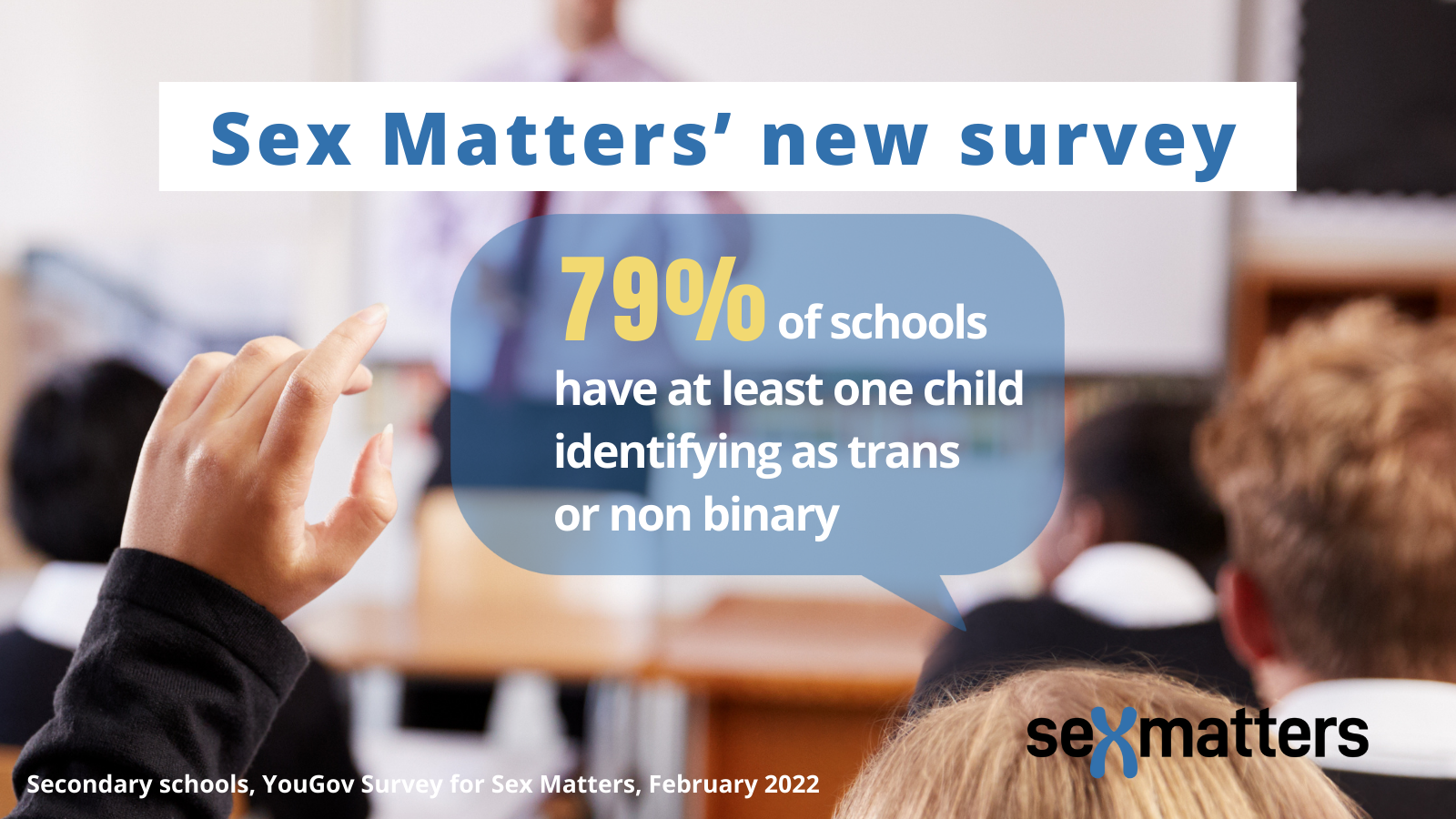Most secondary schools now have trans-identified pupils: Sex Matters’ new survey
Anyone who interacts with young people will surely have noticed that trans identities are becoming more common – and varied. To get a measure of scale of this social shift, Sex Matters commissioned YouGov to poll secondary-school teachers about their experience of trans-identifying pupils. The findings provide the first hard data.

Of the representative sample of secondary teachers, almost four-fifths (79%) said that their school had at least one pupil on its roll who identifies as trans or non-binary. Of those, 85% said they had seen an increase over the past three years. Nearly three-fifths said that seeing well-known trans or non-binary people in the media had played a part in these pupils’ identities; around the same share thought that knowing other trans or non-binary pupils was a factor.
The upwards trend is not the only striking thing about the new data. It suggests that the rising number of gender-distressed kids is best understood not as a “trans” issue, but as a crisis of girlhood. Almost half (46%) of teachers with trans or non-binary pupils say that the majority are female; 19% say the numbers are roughly equal and only 7% say the majority are male.
A soaring number of girls, it seems, are seeking to opt out of being female.
Perhaps this should not come as much of a surprise. Celebrity culture and social media present girls with ever more airbrushed and unattainable female bodies. Most teenagers have been exposed to pornography, which is becoming ever more violent and degrading. Sexualised bullying of girls, even sexual assault, is horrifyingly commonplace. Compared with the previous generation, today’s youngsters live in a rigidly gendered world, with young girls’ clothing often startlingly age-inappropriate, and plastered with exhortations to “be kind” and the like. A gender non-conforming girl, faced with such rigid gender roles, may respond with the only sort of rejection she can find: a trans or non-binary identity.
The most concerning finding, however, is that some schools are excluding gender-distressed and trans-identifying children from standard safeguarding procedures. Almost a fifth of the teachers who responded say that they would not, as a matter of course, inform parents if their child adopted a cross-sex identification at school. A third say they would do so only with the child’s express permission; only 5% say they would proactively inform parents. Transparency with parents is a basic safeguarding principle. It should be breached only if a detailed assessment suggests it would put a child at risk. A child’s trans identification may have been triggered by a problem such as depression, anxiety or bullying that can only be managed in co-operation with parents.
By keeping parents in the dark about their children’s gender distress or confusion, schools risk shutting parents out.
A fifth of teachers say that, in their school, trans-identified pupils are allowed to use facilities intended for the sex they identify with, rather than the sex they actually are. This approach is downright dangerous. For very good reasons, school-premises rules require separate toilets and changing rooms for pupils aged eight and over. Allowing a child to use opposite-sex facilities goes against recent guidance from the Equality and Human Rights Commission and undermines privacy and dignity for other pupils. It also sets the child on a course of “social transition”: this is not a neutral accommodation, but a significant intervention, as emphasised by Dr Hilary Cass, the eminent paediatrician currently undertaking an official review of the care of gender-distressed children.
Behind this mess is a big societal shift that schools have been left to handle without official guidance.
Three-fifths of the respondents to our survey said that they want more official guidance, for example classroom resources on gender-identity issues that have been approved by the Department for Education. Without such quality control, schools can unintentionally promote unscientific and developmentally inappropriate materials, despite their best intentions.
Sex Matters has reviewed schools guidance and classroom materials from LGBT organisations and local authorities. Much of it misrepresents school regulations, equality law and even basic biology. When challenged in courts, local authorities have withdrawn such guidance. But even now Mermaids is producing “fact sheets” defying the EHRC’s advice on single-sex services.
To help schools treat all pupils with fairness and dignity, Sex Matters, together with Transgender Trend, has updated its guide on the Equality Act for schools in England. (Updated versions for the other nations will be released soon.)
Reports in the Sunday Times on 9th April suggest that the Department for Education is in the early stages of producing guidance for schools on dealing with trans pupils, after the EHRC was inundated with queries from teachers seeking information on their legal responsibilities. Greater clarity cannot come too soon: as long as misleading information is allowed to keep circulating, schools, children and parents will continue to struggle.
Read a write-up of our research in the Times, 10th April 2022.
Access the data from our survey, conducted by YouGov between 2nd and 12th February 2022:
